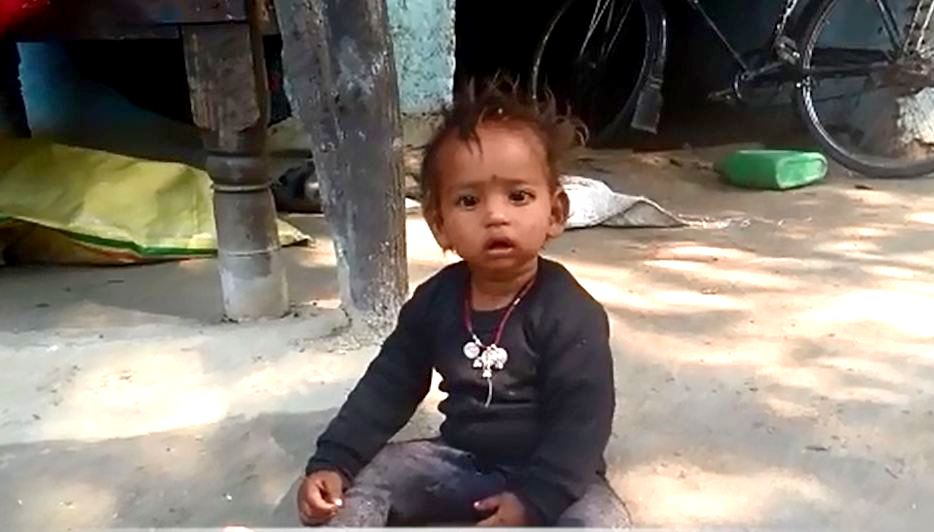Despite the solid work in the area, India houses 50% of the world’s under-nourished children. A report from a village in Bundelkhand, examining the systemic gaps on the ground
“There are 31 malnourished children in this village,” said Heera Bai, who works as an anganwadi worker in Darauna, Lalitpur. As a community healthcare worker of a program that was established in 1975, one of her main tasks is to provide nutrition education and supplementation by guidelines defined by the Ministry of Women and Child Development. Anganwadi services are a part of the Integrated Child Development Services (ICDS), the oldest anti-malnutrition program in the world. But the facts that data spell out are nothing short of tragic: Despite being in effect for over four decades, research has found that India houses about 50% of all undernourished children of the world.
Sonam’s year-old daughter is severely under-nourished. According to Sonam, “She has been like this since she was born,” and in turn, has been suffering, “She has repeated colds, malaria, cough attacks, diarrhea, and has developed allergies around certain vaccines.”
Malnutrition among children is highly prevalent in Uttar Pradesh, the most populous state in the country. According to the National Family Health Survey or NFHS 2015-2016, 48.5% of children under the age of 5 in rural U.P. are stunted; and 17.9% wasted. Add a meagre 5% of children under the age of 2 receive an adequate diet.
Heera Bai, in-charge of the local anganwadi centre stated that she doles out “nutritious food” to the children who attend school as part of the mid-day meal program, “Malnourished children are given double packets every day,” she confirmed. But her primary intervention, she explained, is geared towards promoting nutritional diets and not fighting malnutrition, “My advice to parents is that they should give their children healthy and nutritious food, and if they are severely malnourished, they should be admitted in the NRC.”
NRCs, or Nutritional Rehabilitation Centres, are government-run facilities that provide care for severely malnourished patients, with access to nutritious food and nutrition counseling. However, Heera Bai has noted a general resistance amongst the locals with regard to NRCs. When she recently asked the mother of a critically malnourished child to get him admitted to the NRC for better care, the mother dismissed her, “She simply said she doesn’t have the time for that.”
Despite the resistance, Prabha Chaudhari, officer in-charge of the Bal Vikas Pariyojna for the district of Lalitpur, noted, “There are 12 children admitted into NRCs every month, six for every two weeks.” To tackle the severity of the problem, Chaundhari explained that it is important to spot it as soon as possible. “It is crucial that for the first two years of a child’s life, he or she is weighed regularly – a facility that is provided for, at every centre.”
Sunita, the mother of a two-year-old, though refuted this, “My child has never been weighed.” When asked why, she said, “We never get proper attention or care when we go to anganwadi centres.”
Research has shown that a bottom-up approach to tackling the problem of malnutrition is necessary; information disseminated by the ASHA and anganwadi workers resulted in positive changes in the perception of the importance of nutrition in the community. But despite a Rs.19, 834 crore allocation for anganwadi services in the 2018-2019 budget, the reality on the ground reflects dire situations. Only 49% of under-six children are registered for ICDS benefits and go to anganwadi centres. There is an overall scarcity of equipment such as weighing machines and teaching aids in 82% of anganwadi centres. The workers suffer from a multitude of hindrances and problems, including lack of training, irregular payment, lack of job standardization, poor compensation. And despite PM Modi’s promises in 2018 to change that, anganwadi workers took to the streets repeatedly to make their demands heard, throughout last year.
This grim situation prevails in the country despite constitutional support and legislative policies and plans like the ICDS, the mid-day meal scheme and the 2017 National Nutrition Mission, or POSHAN. The result being that 3,000 children die every day from inadequate diet-related illnesses. Darauna in Lalitpur will only add to this horrific count.
This Khabar Lahariya article first appeared on Firstpost.


